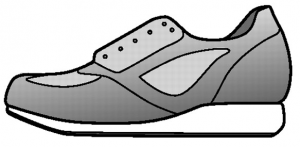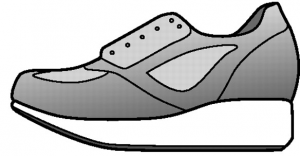Footwear Modifications
Footwear Modifications:
A shoe can be modified in a variety of ways to to treat foot conditions and alleviate pain and discomfort during gait.
Pedorthic shoe modifications offer many advantages. Ready made shoes can be modified to address many foot problems and are less expensive than custom shoes.
Objectives
- Aid in the transfer of forces
- Off-load at-risk or sensitive areas of the foot
- Re-balance or realign the musculoskeletal system
- Control motion
- Improve stability
- Accommodate deformities and areas of pressure
- Relieve pain
Some common shoe modifications include: rocker soles, stabilizers, extended steel shanks, solid ankle heel cushions (SACH), wedges, build-up for leg length difference, balloon patch, ball and ring stretch, excavations, etc.
Rocker Soles
A rocker sole is one of the most commonly prescribed shoe modification. As its name suggests the basic function of a rocker sole is to rock the foot from heel-strike to toe-off with out bending the shoe. The biomechanical effects of a rocker sole are: 1. to restore motion in the foot and/or ankle related to pain, deformity or stiffness, resulting in an overall improved gait. 2. relieve pressure on some area of the plantar surface.
There are a number off variations of rocker soles which are designed to treat specific conditions:
 Mild rocker – The most widely used and basic rocker sole has a mild rocker angle at both the heel and toe. This type of rocker sole can relieve metatarsal pressure and may assist gait by increasing propulsion and reducing the amount of energy expended in walking.
Mild rocker – The most widely used and basic rocker sole has a mild rocker angle at both the heel and toe. This type of rocker sole can relieve metatarsal pressure and may assist gait by increasing propulsion and reducing the amount of energy expended in walking.
Heel-to-Toe rocker – This type of rocker sole is shaped with a more sever angle at both the heel and toe. It is intended to aid propulsion at toe-off, decrease heel-strike forces on the calcaneus and decrease the need for ankle motion. The heel-to-toe rocker sole may be indicated for patients with fixed claw toe, rigid hammer toe, mid foot amputation, calcaneal ulcers, etc.
 Toe-only rocker – The toe-only rocker sole has a rocker angle only a the toe, with the midstance extending to the back end of the sole. this rocker sole increases weight bearing proximal to the metatarsal heads, provides a stable midstance and reduces the need for toe dorsiflexion on toe-off. Indications for the toe-only rocker sole include hallux rigidus, callus or ulcer on the distal portion of a claw, hammer or mallet toe, and metatarsal ulcers.
Toe-only rocker – The toe-only rocker sole has a rocker angle only a the toe, with the midstance extending to the back end of the sole. this rocker sole increases weight bearing proximal to the metatarsal heads, provides a stable midstance and reduces the need for toe dorsiflexion on toe-off. Indications for the toe-only rocker sole include hallux rigidus, callus or ulcer on the distal portion of a claw, hammer or mallet toe, and metatarsal ulcers.
Severe-angle rocker – The rocker sole has a rocker angle only at the toe but at a much more sever angle than that found on the toe-only rocker sole. The sever rocker angle at the toe eliminates the weight -bearing forces anterior to the metatarsal heads. This rocker sole is indicate for extreme relief of ulcerated metatarsal heads.
Negative-heel rocker – Shaped with a rocker angle at the toe and a negative heel, this rocker sole positions the heel lower than or even with the ball of the foot when the patient is standing. the negative- heel rocker sole can accommodate a foot that is fixed in dorsiflexion and shift forefoot pressure to the hindfoot and midfoot. Indication for negative-heel rocker soles include an ankle fixed in dorsiflexion, prominent metatarsal head with extreme ulcers or callusing and distal to ulcers.

Double rocker – The double rocker sole is a mild rocker sole with a section of the sole removed in the midfoot area. I appears to be two rocker sole, one at the hindfoot and one at the forefoot, and provides two area of midstance. Since the thinnest area is at the midfoot, the double rocker sole is used to relive a specific midfoot problem area, such as a midfoot prominence associated with a rocker-bottom foot or a charcot foot deformity.
Stabilizing -- Flare, Buttress
Stabilization involves adding a flare or stabilizer/buttress to the medial or lateral portion of the shoe to stabilize the foot.
Flare – is an extension to the heel and/or sole of the shoe. Flares can be medial or lateral and their purpose is to stabilize thee hindfoot, midfoot or forefoot.
Buttress – is an extension added to the side of the shoe, including both the sole and upper. Made from rigid foam or crepe, a stabilizer provides more extensive stabilization than a flare. it is used for sever medial or lateral instability of the hindfoot or midfoot, such as with a medially collapsed Charcot foot.
Extended Heel Shank
An extended steel shank is a strip of steel that is inserted between the layers of the sole, extending from the heel to the toe of the shoe. the extended steel shank is most commonly used in combination with a rocker sole and often makes the rocker sole more effective. An extended steel shank can also prevent the shoe from bending, limit toe and/or midfoot motion, aid propulsion on toe-off, and strengthen the entire shoe and sole. It is indicated for hallux limitus or hallux rigidus, limited ankle motion and more proximal partial foot amputations.
Solid Ankle Heel Cushions (SACH)
Wedge
A wedge of sole material is added to the medial or lateral side of:
- the heel
- the sole
- or both heel and sole
 It can be inserted between the upper and the sole or added directly to the bottom of the shoe to redirect the weight-bearing position of the foot. A wedge is useful in stabilizing a flexibly deformity in a corrected position or in accommodating a fixed deformity by bringing the ground to the foot. A medial wedge is indicated in cases of extreme pronation, and a lateral wedge can be used for ankle insatiability or a varus heel deformity.
It can be inserted between the upper and the sole or added directly to the bottom of the shoe to redirect the weight-bearing position of the foot. A wedge is useful in stabilizing a flexibly deformity in a corrected position or in accommodating a fixed deformity by bringing the ground to the foot. A medial wedge is indicated in cases of extreme pronation, and a lateral wedge can be used for ankle insatiability or a varus heel deformity.
Build-up for Leg Length Difference
For patients with documented leg length differences the internal portion of the shoe can be raised up to 3/8 inch to accommodate for the difference. Leg length differences greater than 3/8 inch must be made up by adding to the outsole portion of the shoe with light weight foam materials.
Balloon Patch
A Balloon patch is a hole cut in the upper over the prominence of the joint, repaired with a stretch patch of leather dyed to match the shoe upper and provide a wide pocket to accommodate a deformity, prominence or sensitive area
Ball and Ring Stretch
Occassionally the upper material portion of the shoe must be stretched to create additional room in the shoe for a specific deformity. A Ball and ring stretcher or other stretching presses can be used to stretch small portions of the shoe which will increase the room of the shoe. Not all shoe materials or shoes are suitable for stretching.
Excavations
Excavations are made to the inside of the shoe where material is ground down in specific areas to reduce the pressure on sensitive areas.




